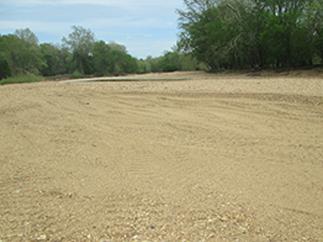
Many Missouri streams provide an abundant and easily accessible source of sand and gravel for construction activities. In-stream sand and gravel mining is one of the most prevalent types of mining in Missouri, as far as the number of sites. However, in-stream sand and gravel mining is somewhat of a misnomer because this mining method does not allow for excavating machinery to mine in the flowing portion of the stream. This mining method would be more accurately described as a bar skimming mining operation.
Bar skimming is limited to the exposed portion of a gravel bar above the water line, within the ordinary high banks of a stream but not within the flowing water. Bar skimming is recommended as a means for advancing stream resource conservation while maintaining a viable extraction industry. This type of gravel removal operation lowers the risk of forward erosion of the stream channel upstream and sedimentation downstream from the area of excavation. In addition, the practice of removing gravel at periods of low water flow will aid in protecting wildlife near the stream environment. Some of the rules include: staying an adequate distance from the stream bank, use of existing crossing areas, leaving an undisturbed buffer of 10 feet from the flowing water line and no mining below the water line. There are some circumstances when the operator can apply for and receive a variance after multi-agency consultations have occurred which generally involve the Missouri Department of Conservation and U.S. Army Corps of Engineers (USACE).
Removal of sand and gravel from streams can cause damage. The Missouri Department of Natural Resources is concerned that gravel removal be done properly in order to minimize impacts to landowners upstream and downstream. Other agencies, state and federal, have authority under existing regulations to help protect the health of streams.
